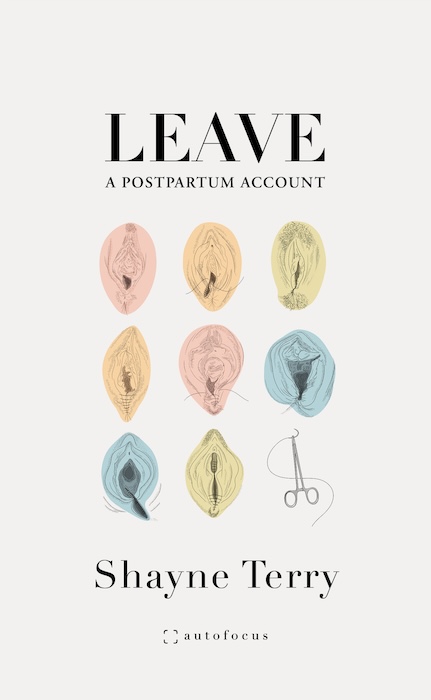Electric Literature is pleased to reveal the cover of Leave: A Postpartum Account by Shayne Terry, which will be published by Autofocus Books on February 25, 2025. You can pre-order your copy here.
Shayne Terry’s fourth trimester is not going as planned. Instead of bonding with her new baby, she’s stuck on the couch with a third-degree tear, barely able to walk. When the women in her family show up to help, they come bearing family secrets and old wounds that also need repair. Begun as notes on Terry’s phone documenting a parental leave gone awry, Leave: A Postpartum Account examines a healing process complicated by capitalism, intergenerational trauma, and a healthcare system with a long history of devaluing women. This powerful postpartum account treats birth as a portal, one that can connect us to a lineage of pain, joy, death, and life. And at a time when our bodily autonomy is being stripped away, Leave is an urgent exploration of one woman’s experience recovering from birth in America.
Here is the cover, designed by Amy Wheaton:

Author Shayne Terry: “Early on in this project, I thought I was writing an essay. That essay grew longer and longer until I realized I might be working on a book. This was 2021 and I was spending a lot of time researching obstetric anal sphincter injuries, trying to understand what had happened to me by reading articles in medical journals and watching surgical repair instructional videos on YouTube. I was captivated by the line drawings I encountered in medical textbooks and how much they resembled botanical illustrations. I decided to include my own drawings in the project and imagined them as chapter headings or separating parts of the book. I am not, however, an artist, and I was never satisfied with my drawings, so eventually I abandoned them.
Fast forward to 2023, when I first spoke with Michael Wheaton at Autofocus about the book. Two things he said made me certain that Autofocus was the right home for this very personal story. The first: ‘This is a book that pretends to be about birth, but it’s really about death.’ He got it. The second thing he said was that his wife Amy, who does all the cover illustrations for Autofocus books, had experienced a similar injury. I understood immediately how meaningful it would be to work with Amy on the cover.
I suggested the medical textbook illustration style, and Amy took that direction and knocked it out of the park. I love that the cover gets in your face; this book is not for everyone, and a good cover enables readers to self-select. At the same time, the colors Amy chose serve to soften the body horror, in my opinion, just enough. The cover is subversive, bold yet gentle, and I know it will help the book find its people.”
Designer Amy Wheaton: “Shayne has taken this painful thing that happens to so many women and written about it in a way that makes me feel understood — as I know this work will do for so many others. I loved Shayne’s idea to do a medical drawing or a series of drawings of vaginal tears. I’ve long been interested in that style of illustration, and having torn badly myself during my first son’s birth, I thought it completely necessary to represent the book in this way. I thought about all those who will find community in her words. I wanted to represent her, them, and myself.
I looked through as many photos and medical illustrations as I could find—different degrees of tearing, stitching, episiotomies. I drew a series in-line with the style we’ve developed for Autofocus covers. I thought about Shayne’s experience, I thought of my own experience, the lack of research there is on female health, the treatment women of color experience in contrast. At first, I thought to use different skin tones on the illustrations, but instead opted for colors unnatural to the skin to show the female anatomy the way it is often treated in procedures like these, as a means-to-an-end for birth. I lined them up like numbers, leaving the last spot for sterile instruments, the inverse of the female anatomy.”
Take a break from the news
We publish your favorite authors—even the ones you haven’t read yet. Get new fiction, essays, and poetry delivered to your inbox.
YOUR INBOX IS LIT
Enjoy strange, diverting work from The Commuter on Mondays, absorbing fiction from Recommended Reading on Wednesdays, and a roundup of our best work of the week on Fridays. Personalize your subscription preferences here.
